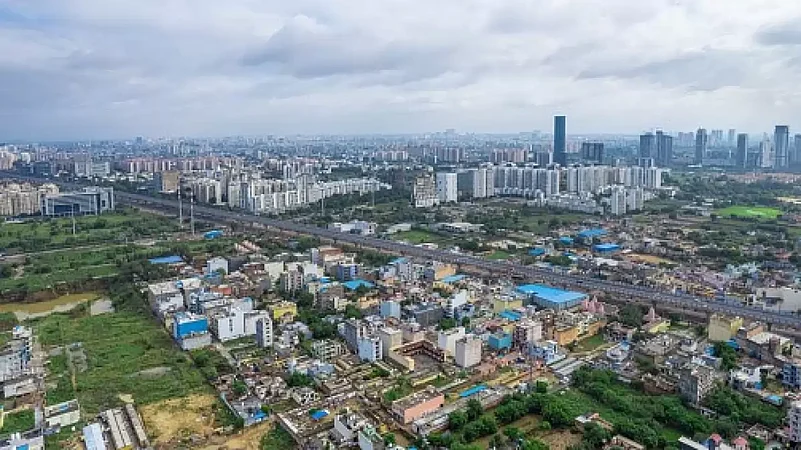“The past is a foreign country; they do things differently there”—LP Hartley’s opening lines in his novel The Go-Between referred to the past as a foreign country, how it is a vague memory in our heads, so nebulous we are often left wondering if a certain incident happened this way or that.
Likewise, Karnataka, too, is a ‘foreign country’—things happen differently here from an Uttar Pradesh or Bihar; it looks vastly different from a West Bengal or Madhya Pradesh. However, unlike Hartley’s nostalgic past, Karnataka is all about the future, a promising one at that.
Even in the remotest villages on the way from Chikkamagaluru to Hubballi where we stopped to talk to people during our recent travels to cover the elections, the houses are pucca, the roads are concrete, and most houses had water coming in the tap.
Over the past decade, Karnataka has grown much faster than the rest of India—rising from 16th to become India’s third-richest state by per capita income, behind only to tiny Goa and Sikkim. Karnataka’s average income doubled in the 2010s to $3,800 (about Rs 3.3 lakh per annum, much more than double the national average). Since India’s post-Independent records began in 1960, no other major state has ever risen so fast, writes investment banker and Wall Street wizard Ruchir Sharma in The Financial Times.
“The credit should go to our engineers, our technicians and the Mysore maharaja (the Wodeyars), who started the industrialisation of Karnataka. They were far ahead of the times,” says Chief Minister Basavraj Bommai when we meet him at his residence in Hubballi.
He mentions how the strong collaboration between the Public Sector Undertakings (PSUs) and institutions, the presence of defence and space technology institutions like the Defence Research and Development Organisation (DRDO) and Indian Space Research Organisation (ISRO), and the presence of the IT sector and 400 niche R&D centres, ranging from genetics and aerospace, have all contributed to the growth of Karnakata.
Bengaluru’s tech success has spread to the interiors in myriad ways. We stop at a village called Korlahalli, about two hours from the state capital. The brightly painted houses in neat rows on the front—some two and three-storied—are of the Vokkaliga farmers.
Deeper into the village where the streets get narrower and houses smaller, live the Scheduled Caste and the Muslims. Here we meet Zafar, who would be in his 30s. He is wearing track pants and t-shirt and his beard and brows are sweaty with the high humidity. “WFH” (work from home), pat comes the reply when we ask him what he does. He lives in a small two-room house with his wife, children and father and works in the accounts department of Budweiser, a beer company in Bengaluru.
“There is no wi-fi here. I use a dongle on my laptop. It’s slow, but I manage. I have been working from here for the past two years. It saves the Rs 8,000 rent I used to give in Bengaluru,” he says.
There is one drawback of WFH though. In Bengaluru, he used to get 21 bottles of Bud free every month, which he misses!
The family is much better off financially with Zafar’s job, but it has come at a price. Zafar’s father Hussain is a farmer who just about makes enough to get by. He is happy with his son’s job but is anxious about the growing suspicion between the Muslims and the others in his village. He says there has never been any communal problem in the village all the years he has lived there.
But now, in recent years, the tension has grown, and things become worse during elections. “We used to meet all the other families in the village freely. Now we keep to ourselves,” he says quietly, his old eyes getting moist.
The communal rhetoric in speeches and rallies has not been so shrill in these elections. The pre-election issues like the hijab controversy, the azaan restrictions, Tipu Sultan, the Popular Front of India (PFI) ban and Uniform Civil Code were mentioned only cursorily. Has the thrust shifted from Hindutva to development, jobs and price rise this election?
“Sometimes I wonder why certain issues are categorised as pro-Hindutva and others are not. There is no such categorisation,” says Bommai.
Giving the example on the ban of the PFI, he says: “Do you think it is a Hindutva issue? It is an administrative decision to ban the PFI, which is anti-national. Just because a lot of the members of the PFI are from the minority doesn’t mean that it is pro-Hindutva. When we talk of something historical, you say it is Hindutva. But if the Congress does the same, you say it is secular. What is secular itself is a big question now. If you are pro to certain communities, does that mean you are secular?”
While that question hangs, the new government in Karnataka will have to take steps not to let up the 8 per cent growth the state has shown in the past few decades. But does it matter at all? Because Bengaluru and Karnataka have grown the fastest when political stability has been at its worst. Consider this—the state has had a new chief minister about every two years.
















